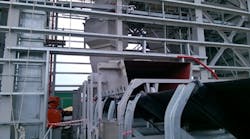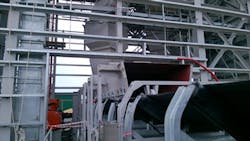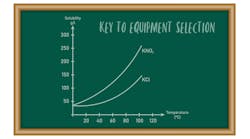Airborne dust afflicts many plants. Processes such as impaction, disintegration, fracturing, grinding, crushing, etc., generate particulates that then disperse into the air. These particulates come in a wide range of sizes and many remain in the air indefinitely. Such dusts often can harm both people and equipment. So, plants should strive to eliminate or at least minimize dust generation and emission.
Preventing the generation of dust generally is easier, cheaper and more reliable than trying to control and suppress generated dusts. Although total prevention of dust in many plants and during operations such as bulk material handling, conveying, size reduction, etc., is impossible, properly designed facilities and equipment can play an important role in reducing dust generation, emission and dispersion.
However, many facilities must resort to dust control and suppression. So, here, we will look at the two most important methods: dust collection and wet suppression (i.e., using water sprays to reduce the dust generation and capture airborne dusts).
Figure 1. Skirting on belt conveyor at the loading/impact point (tail end) extends sufficiently to reduce dust propagation.
Minimizing Generation
Facilities often have many potential dust generators. For example, belt conveyors can emit dust from different points. The tail end, where material is received, usually is the main point of dust generation because of the many impacts of materials there. However, dust also can come from the conveyor skirting, the return idlers (due to carryback of fine dust on the return belt), and the head end, where material is discharged. With mills or crushers, the size reduction process itself generates significant amount of dust, which can emerge from any uncovered or unsealed parts of the equipment. In addition, material stockpiles often can create dust.
Some other major areas for dust generation are transfer points, chutes and the discharges of hoppers or bunkers. The amount of dust generated in these places depends upon the specifics of how material is handled, unloaded or loaded. Reducing dust generation often is possible. For example, material being discharged onto a belt conveyor should be loaded onto the center of the belt; the material and the belt should travel in the same direction and at the same speed whenever possible.
Where and how the material is discharged are important. Design and configuration of discharge locations should minimize the dust generation. Many facilities use devices such as skirt-boards to keep the material on the conveyor after it’s received. These skirt-boards usually have flat rubber strips or something similar to provide a dust seal between them and the moving belt. These seals require proper design; otherwise short life and operational issues will ensue.
Running operations at full capacity and equipment fully loaded can boost the amount of dusts due to many effects and issues such as spillage, increased impact, etc. This is particularly true for size reduction processes, separation units, screens and material handling systems. For instance, it’s preferable to design a belt conveyor to operate at 75%–80% of its full rated capacity; this reduces spillage, dust emission and wear on different parts such as seals, etc.
Chutes used at transfer points for moving materials from one piece of equipment (such as a conveyor) to another require serious design attention, too. Inadequate designs can result in significant dust generation. The chute should be big enough to avoid jamming of materials. It should be designed so the material falls on the sloping bottom of the chute, not on the subsequent equipment. Wherever possible, materials should fall on a local hard lining rather than on the metal surfaces; this will cut dust and noise generation, lessen wear and abrasion of the chute surfaces, absorb the impact of incoming material and, more importantly, reduce dust emission. When handling fine or abrasive materials, consider welding a number of small steel angles on the chute bottom; the oncoming material slides on the material stored in angles, greatly reducing wear and abrasion of the chute bottom.
Dust Control
In selecting a dust control system, you should consider many factors — e.g., desired air quality, applicable regulations or standards, interactions with the process and facilities, space or budget limitations, required reliability, etc. Conduct a thorough survey of facilities needing dust control and perform a detailed evaluation before deciding whether to opt for a dust control system, dust suppression or a combination of the two. Place emphasis on the process, operating conditions, characteristics of the equipment, associated dust problems, and the harmfulness or toxicity of the dust. Properly identify major dust emission points and conditions that occur at these points during normal operations; sometimes each point needs a specific solution.
After doing whatever is practical to prevent or reduce the dust generation, the next step is to deal with the dust that is generated. In many applications, plants automatically turn to dust collection rather than water spraying or wet suppression. The common view is that dust collection, theoretically at least, can provide reliable and efficient control over a long period; however, the capital and operating costs are very high. Wet dust suppression systems, particularly water spray systems, are somewhat less efficient, and, thus, theoretically less desirable. Such systems, are less expensive to install and operate, though. Water-spray systems are the simplest and most widely used dust suppression system but they require careful selection and planning to be suitable, effective and reliable.
Let’s now look at collection and water-spray suppression systems in a bit more detail.
Collection
Dust collection systems use ventilation principles to move the dust-filled airstream from the source through ductwork to a collector system. In effect, this exhaust ventilation system works like a household vacuum cleaner. It is one of the most effective ways to control dust and reduce dust emissions. A typical dust-collection system consists of exhaust hoods, ductwork, dust collector and a fan set. A system of exhaust hoods is needed to effectively capture dust emissions at their sources. Proper design of the network of exhaust hoods is crucial for capturing all or a large portion of generated dusts from many different points. Well-designed ductwork also is necessary to transport the captured dust to a dust collector that then removes the dust from the air. A fan system, often with one unit operating and another on standby, usually provides the necessary exhaust volume and energy. Each of these elements is important — poor performance of one component can reduce the effectiveness of the other components. Pressure calculation and a proper airflow are very crucial for any dust collection system. Because the fan set provides the pressure required to start and maintain the airflow, correct sizing of the fans and their operational flexibility are important.
The exhaust hood, which is the point where dust-filled air enters a dust collection system, is one of the most critical parts of such a system but often doesn’t receive adequate attention. It should capture dusts efficiently and effectively; otherwise the whole system becomes dysfunctional. Exhaust hoods come in many variants — e.g., local, side, downdraft and canopy hoods. Local hoods, which are available in numerous sizes, shapes and designs, are relatively small units for localized dust collection; they normally are located close to the point of dust generation and capture the dust before it escapes that area. Local hoods usually are efficient and find wide use for many processes and plants. Such applications typically involve a vast network of many local hoods, each positioned near a dust-emitting point. Side, downdraft and canopy hoods are larger versions of local hoods. They cover a greater area or multiple dust generation points and, thus, usually are less efficient than local hoods. There also are large hoods for booths, rooms and enclosures; these sometimes are used for screens, conveyors, etc., but aren’t particularly efficient in these applications.
Developing the most-effective exhaust hood system requires sufficient knowledge of the process or operation. Hoods must be installed at the right locations with proper operating parameters. The size and shape of hoods are important to ensure effective capture of the generated dusts. In addition, the airflow through each hood must be set properly; this rate is related to the distance between the hood and the dust source. The duct network needs a careful design as well. To prevent dust from settling and blocking the ductwork, adequate transport velocities are essential; as a rough indication, a velocity range of 16–20 m/s often makes sense. Smooth turbulence-free air flow is important. So, follow good engineering practice to minimize turbulence. For instance, all branches should enter the main duct at a proper angle, say, 30°, and, wherever possible, the velocity should match that of the incoming fluid stream.
Water-Spray Suppression
These techniques use water sprays to wet the material so it generates less dust. Most such systems also rely on a water spray system to capture airborne dusts. The spraying of fine droplets of water on the dust cloud causes droplets and dust particles to collide and form agglomerates that are too heavy to remain airborne. Such a wet system obviously only is suitable for applications that can tolerate adding some water to the materials and where processing isn’t seriously affected by such spraying. Many such applications exist. Indeed, finely atomized water sprays are widely used at many facilities and locations such as conveyors, transfer points, etc., for the dust suppression.
Dust suppression via a water spray may seem simple but actually is very complex and chaotic in nature. For instance, the collision between dust particles and water drop occurs due to many factors and effects such as impact, interception, electrostatic forces, etc. The optimum droplet size, water usage, relative velocity, and number and location of nozzles depend upon the conditions at individual dust generation locations. System design often reflects a combination of sound engineering practice, vast experience and art.
The spray nozzle is the heart of a water-spray system. Therefore, details and characteristics of the spray are critical. You must carefully calculate and evaluate velocities, droplet sizes and pattern, and other operational details. Factors such as droplet size distribution and velocity, spray pattern and angle, and water flow rate and pressure all vary depending on the nozzle selected. (For more information on types of nozzles, see “Spray Effectively.”) The nozzle’s droplet size distribution is one of the most important variables for proper dust suppression. The droplet size decreases as the operating pressure increases. Moisture addition to the materials should be quite low, typically less than, say, 0.2%–0.3% of the material weight. This generally translates to a low water feed to each nozzle; as an indication, this may amount to somewhere around 30–70 L/h. Some delicate systems add less than 0.1% of the material weight. Another consideration is where and under what conditions and circumstances to spray the water. The system may not be effective either in highly turbulent environments or when the dust dispersion rate is more than 1 m/s.
The effectiveness of wet dust suppression systems depends on having many small droplets moving at optimum velocities. Many older systems did not pay sufficient attention to this. Today, systems generally use a greater number of smaller nozzles, carefully distributed for better dust suppression. In addition, they provide better control (such as via a control valve) to let the operator optimize water discharge. Airborne dust capture systems may require very fine droplets. These fine droplets usually are generated by fogging nozzles, which may use either compressed air or high pressure water to atomize water in the desired droplet range.
It’s best to use nozzles that are adjustable in direction. This will allow operators to alter the path of the water spray, for example during a shutdown or trip, for better dust suppression. You can gain additional operational flexibility by making provision for moving and adjusting nozzle locations.
Hydraulic calculations for water spraying system as a whole need great care; correct sizing and design of the system require properly determining the water necessary for each point in each mode of operation. The spray system for each location or zone must have a control valve to enable flow regulation as well as an on/off valve for isolation. Optimum operation depends upon an operator having the ability to adjust the flow for the dust suppression operation based on actual observation of the dust emission in each point or zone. Higher water flow than needed is harmful and problematic; lower flow than required adversely affects dust suppression. Install pressure and flow gauges to monitor system performance; locate these instruments as close to the point of application as possible.
AMIN ALMASI is a rotating equipment consultant based in Sydney, Australia. Email him at [email protected].




